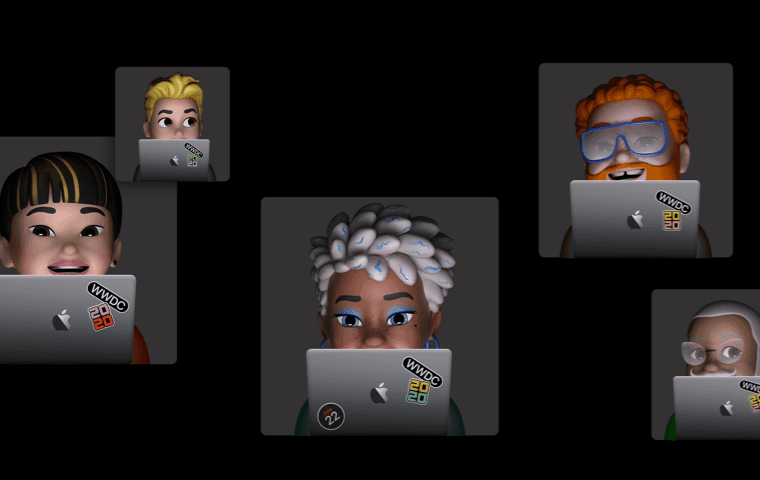This year, WWDC was quite different. For the first time (due to the current circumstances) the conference happened entirely online. Even though we could not attend in person, we felt that all the videos were extremely well-produced and the experience was great. Everyone won the ticket lottery this year!
If you’re not a developer, you’ve probably seen the Keynote and maybe the Platforms State of the Union. But there’s a lot more! Every year, there’s a plethora of developer sessions that introduce the newest technologies and updates. With 2020’s online format, the videos are shorter, get straight to the point and highlight the presenters even more than before. To top it off, all of the content is supported by improved documentation for developers.
Well done, Apple! This WWDC was a success!
You can find lists of “new things introduced at WWDC” in dozens of articles online. If you weren’t following the tech side of this year’s WWDC, these recap videos from Apple are a great start: Day 1, Day 2, Day 3, Day 4 and Day 5.
We don’t want to be repetitive here. Instead, let’s focus on how STRV engineers can help you build your next app (or improve your existing one) using the new and improved features now available to us.
First, let’s talk about the Mac. Over the past few years, developers and users alike have been asking the same question: Does Apple still care about the Mac? This year, we got a clear YES as the answer. With macOS Big Sur, the Mac becomes even better than before, and the new tools available to us developers make writing macOS apps a joy. Your apps will look gorgeous on Big Sur and we can help you make it happen!
Catalyst has been around for a year already and developers have built many excellent macOS apps with it. As with all technology, the first releases can be a bit rough around the edges; that was the case here as well. But this year, Catalyst is getting many updates—enhancing both its capabilities and developer comfort.
If you have an iPad app and you’d like to offer your product to a larger audience using macOS, Catalyst is the way to go. Some work is still needed to make your app a good citizen on a computer (is that still the right term?), but most of the work is done automatically by Catalyst for free. Simply by checking a checkbox in Xcode.
Alongside Catalyst, Apple also released another technology last year, one that makes developing user interfaces easier than ever. Yes, we’re talking about SwiftUI.
SwiftUI makes it incredibly easy to create user interfaces for all Apple platforms: iOS, iPadOS, macOS, watchOS and tvOS. Your apps can now share even more code between apps tailored specifically to be good citizens on their respective platforms. This can lead to great time and cost savings.
Of course, with every technology—especially as revolutionary as this one—the first versions tend to be a bit of a gamble. Over the past year, SwiftUI has shown us that it is the right choice. And with the enhancements introduced at this year’s WWDC, we’re excited to finally start using it in apps built for our clients.
Are we ditching UIKit? Definitely not. But we believe that SwiftUI is now good enough to mix and match with UIKit in our client apps. And if you’re willing to support iOS 14 only, a pure SwiftUI app may be the way to go.
Over the past year, STRV has been hard at work learning and researching SwiftUI and Catalyst and writing apps using these two technologies. We’re excited to use our knowledge to build our clients the most modern apps possible.
Getting users to find your app and install it can be tough, as there’s an ever-growing supply of applications in the App Store. Cue App Clips, a great new way for your users to quickly get a sneak peek at the experience and functionality of your app.
Your users can simply scan an App Clip Code or a QR code with their camera—or use an NFC tag, Safari App Banner, link in Message or Place Card in Maps—to open an App Clip. Immediate discoverability, no installation needed.
App Clips are a part of your app, but they’re streamlined and tiny (App Clips must be under 10 MB). They’re built to be downloaded fast and achieve one task, like ordering a coffee or unlocking a bike in a few seconds. They work with Sign in with Apple and Apple Pay, so that your users can get going as quickly as possible. And when the users are done, they can install the full app right from the App Clip!
We can’t wait to integrate App Clips into our clients’ apps, helping them become more discoverable while simultaneously improving the users’ first experience.
Widgets have been on Apple platforms since forever. With iOS 14 and macOS Big Sur, Widget experiences become even more convenient. Users are bound to love them. Up until this update, iOS Widgets have been hidden behind a left swipe. Not anymore. Widgets can now be placed anywhere on the home screen.
Many apps have a good use case for Widget implementation; if you have regularly updated information that the users should see, Widgets are a great tool. Users can see information from the app at all times, every time they unlock their device. This will not only be a great benefit for the end user, but also for businesses because users can be constantly reminded about an app’s value.
Widgets are now built purely in SwiftUI. That’s great news for developers because by doing this, Apple is endorsing and blessing the use of SwiftUI in production. It is likely also one of the reasons why the Widgets we build for iOS and iPadOS also automatically work on macOS.
We think that widgets are a great addition to many apps. And since they’re fairly simple to develop, they can bring a lot of benefit to both you and your end users with little effort.
Apple is constantly improving iPads. They’re so great these days that some of our colleagues here at STRV use them as their daily drivers instead of MacBooks. With so much effort and such emphasis on iPad, we’d highly recommend offering an iPadOS app alongside your iOS app when developing apps for your business.
With all the power features introduced to iPad—Apple Pencil, Magic Keyboard, LiDAR Scanner and more—and the constant updates to usability of iPadOS, this is a platform that should not be ignored.
Apps built for iOS run on iPadOS and that is great. If your app is to be successful on all Apple devices, we can help you create a tailored iPadOS User Interface that takes advantage of the large screen, Magic Keyboard, Apple Pencil and more.
And as we mentioned above: It’s a short ride from a great iPad app to a great Mac app.
There has been a strong push towards Augmented Reality technology and its applications on Apple platforms for the past several years. Every year, Apple has been releasing new versions of ARKit, the framework used to build AR applications. This year is no exception.
ARKit 4 brings a brand new Depth-API that leverages the iPad’s LiDAR Scanner to get detailed information about the surrounding world. In other words, your iPad Pro can now “feel” the shapes of things around you. The newly introduced Location Anchors let us place AR experiences at specific places around the world (like near a famous landmark or other point of interest).
Together with enhancements of face tracking technology and other features, 2020 is another strong year for Augmented Reality.
Augmented Reality has a huge amount of untapped potential, especially with the rumored Apple Glasses supposedly coming soon. We expect that porting iOS AR experiences will be smooth, so there’s no better time to start your AR project than now!
At STRV, we have used the gradual releases of ARKit to gain expertise with Augmented Reality and build great AR apps. Now that we’re up and running, we’re ready to augment reality with you!
It seems that Apple has done it again! 15 years ago, Apple computers transitioned from PowerPC processors to Intel. Now, the same is happening with the transition from Intel to Apple Silicon, their custom built ARM chips. We’re yet to see how powerful the new Macs will be but so far, it looks very promising.
What does it mean for you and your apps, though? If you have an existing Mac app, depending on how it was built, it may or may not need some work to run natively on Apple Silicon. We’re prepared to help evaluate and potentially port Mac apps for any client. Meanwhile, Rosetta 2 will run your app by translating the Intel x86_64 instructions to Apple Silicon arm64.
All your new apps will be built for both Intel and Mac with no effort by default.
However, there’s one more thing. Since the Apple Silicon Mac chips are essentially the same thing as iPhone and iPad chips, your iOS and iPadOS apps will run natively on the new Apple Silicon Macs—potentially without any additional effort. Of course, the best Mac apps are the ones that behave like Mac apps, so a great iOS app is not necessarily a great macOS app out of the box. Our designers and engineers have excellent knowledge of both platforms and are able to help you create apps for both of the platforms.
Well, this will most likely not help you build great apps for Apple Platforms, but we’re excited! Not only because Foundation TV series has been a dream of all of us SciFi fans for years, but also because Foundation is the base of all the apps we write for Apple Platforms. We think that the show will be great and that Apple releasing it at WWDC is a nice hidden homage to the platforms!
There’s so much more that we’d love to talk about, but five days packed with news cannot fit into one article. We’re incredibly excited to be Apple developers, and we’re looking forward to developing great apps with you!




